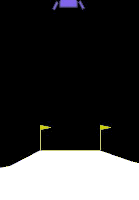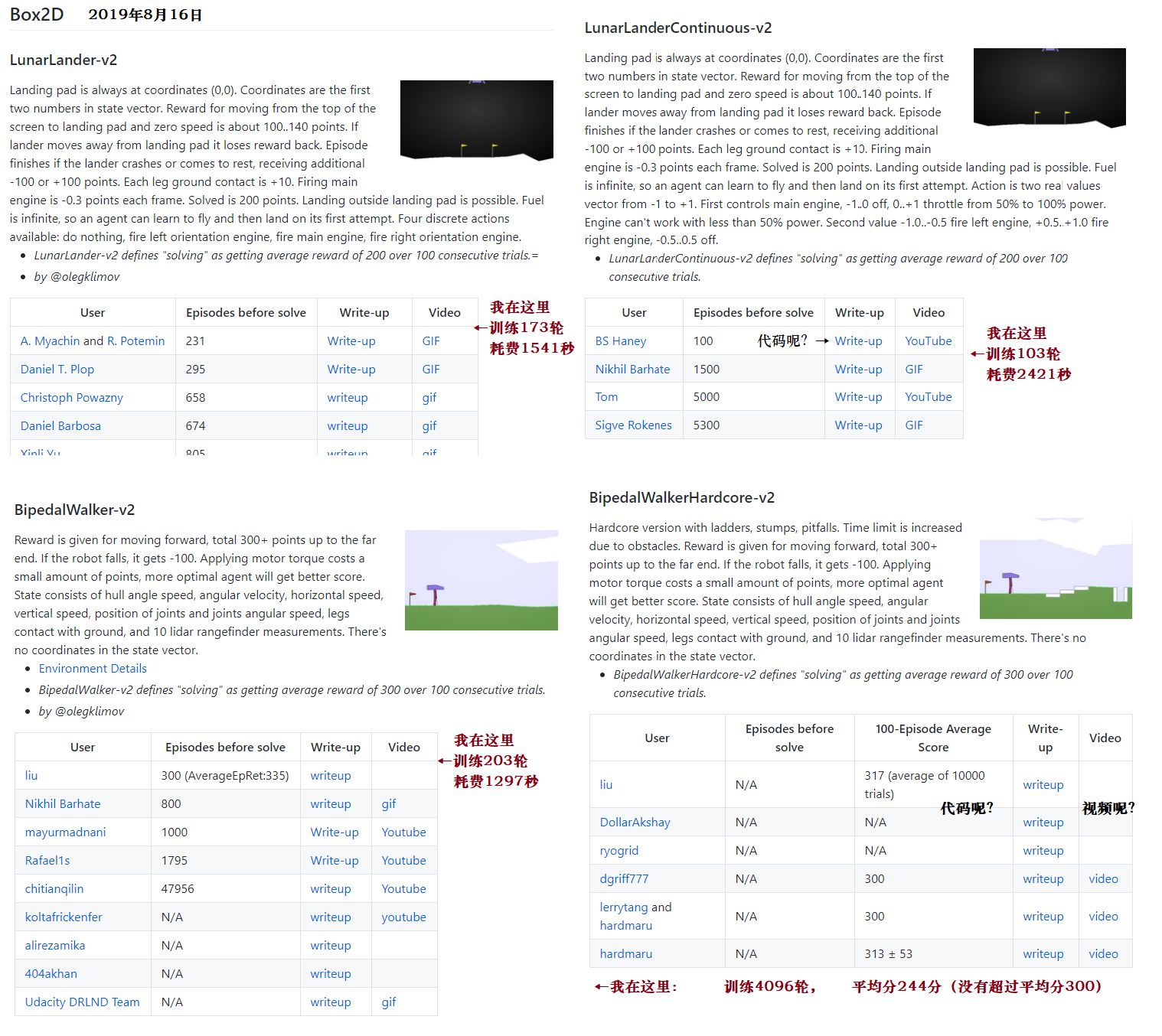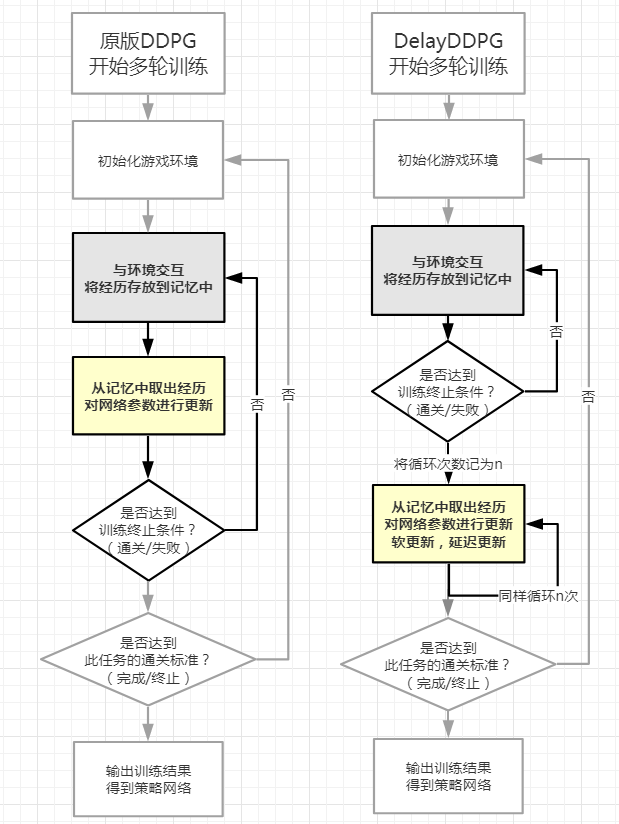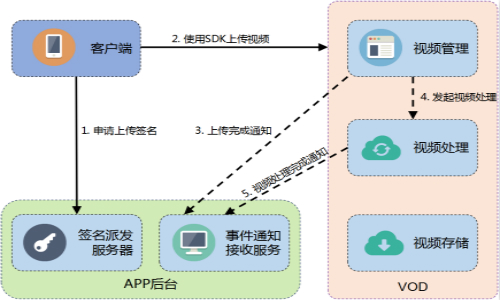详解DDPG算法:解决对大量的超参数、随机重启、任务环境敏感问题,完成月球着陆器,双足机器人demo、以及超参数调优教学
详解DDPG算法:解决对大量的超参数、随机重启、任务环境敏感问题,完成月球着陆器,双足机器人demo、以及超参数调优教学

0.demo展示


当我复现强化学习算法 DDPG 时,我发现论文中缺少必要的实现细节,例如:Gamma、噪声方差、最大训练步数等参数的取值。此外,在我调整参数,成功完成某次训练后,当我对随机种子进行修改,发现训练时长有很大变化,甚至有时候无法完成训练。更别提把在某个任务上 work 的代码换到相似任务上的艰辛历程了。
如果你被这些问题困扰,那么你可能需要这份代码。由于我找不到符合我要求的轮子(2019-08),所以我只能自己造了,我认为这份代码解决了以上问题,符合以下要求:
- 算法适用性广,适用于不同的任务(即便不做修改,也能完成不同的 Gym 的游戏)
- 算法比较简单,代码可读性强(若某个结构加入后对性能提升小,那么删去此结构)
- 算法训练时间短,训练稳定(训练时间不超过 1 小时,即使更换 RandomSeed)
通关双足机器人硬核版 (BipedalWalkerHardcore-v3), 训练比较快(旧记录是 10,000 + 轮) 使用 IntelAC 算法,
4106 轮,1960k 步,31 小时,单 GPU
(平均分 310,target reward 是 300) (不稳定,有时候需要训练 7000 轮,3000k 步,40 小时)
训练最快 4106 轮(用 IntelAC 算法通关双足机器人硬核版)BipedalWalkerHardcore-v3_哔哩哔哩 (゜ - ゜) つロ 干杯~-bilibili
此外,有一个的原创文章 kangaroo CreateAMind 在 2019-07-30 也通关了(使用了采用 state-of-the-art 的 model-free RL 算法 sac1,但是没有公布训练步数)(请注意:他们修改了 Reward 函数,将超时后 done=True 时的 - 100 改为 0),文章还分析了 OpenAI Leaderboard 上的两个解决了’BipedalWalkerHardcore-v2’ 的项目(分别是 A3C+LSTM 与 CMA-ES)。其中 A3C 需要开多个 agent 进行大量的异步交互,LSTM 可能是用来解决这个任务状态转移概率比较难以完整获取的问题。而 CMA-ES(Covariance Matrix 协方差 Adaptation Evolutionary Strategies 自适应遗传算法)则使用了 遗传算法,有它的帮助,在大量交互后,获得巨大优势的个体可以很快地扩散出去(比如学会了在方格上面跳的 Agent)。如果是工业界做机器人的的可不会轻易用这种两种算法,因为会报废掉很多机器人,详细内容去看他们公众号写的文章吧,写得不错:
- 2019-07 CreateAMind RL 解决’BipedalWalkerHardcore-v2’ (SOTA)
- 2019-08 CreateAMind RL 解决’BipedalWalkerHardcore-v2’ (SOTA) 更新
结果出乎我的意料,经过大刀阔斧的修改后,这份代码竟然在 OpenAI 官方的排行榜 Leaderboard 上的 3 个项目都拿了靠前的名次(使用更少的训练步数达到目标分数),如下:

上面的代码参考了「GitHub, nikhilbarhate99 TD3 算法」,删去了 TD3 的双 actor 结构,然后把 Actor-Critic 框架当成 Generator-Discriminator 框架去训练,具体请看:
它可以不对模型进行任何修改的情况下,在下面几个 OpenAI-gym 的开游戏中,达到通关条件(硬件 RTX 2080Ti):
- 月球着陆器:训练 114 轮,1231 秒(LunarLanderContinuous-v2 ,连续动作)
- 月球着陆器:训练 147 轮,1487 秒(LunarLander-v2 ,离散动作)
- 双足机器人:训练 165 轮,2011 秒(BipedalWalker-v2)
- 双足机器人:训练 4096 轮,28,143 秒(BipedalWalkerHardcore-v2,硬核版)平均分 244,无法达到通关条件平均分 300,若有人找到了通关此游戏的开源代码,请告诉我
- 正文目录
- 原版 DDPG 的三个「敏感」:对大量的超参数、随机重启、任务环境敏感。
- 改良 DDPG,克服「敏感」:使用延迟更新,并总结超参数选择方法
- 如何选择强化学习的超参数:Gamma 值,训练步数,噪声方差
- 适应连续、离散的动作
- 适应不同的环境参数
1.原版 DDPG 的三个「敏感」:对大量的超参数、随机重启、任务环境敏感。
对**「敏感」**条件稍作修改,便会显著影响任务训练时间,甚至无法完成任务。我认为以 DDPG 为代表的 Actor-Critic 强化学习框架是具有美感的模型,让我想起了 2014 年的对抗网络(GANs),在 2015 年 GANs 刚出来的时候,也和 DDPG 一样,训练的时候非常不稳定。我想要为解决这个问题出一份力。对此的讨论请移步姊妹篇:xxxx
随机重启:换用 随机种子 random seed,会使得训练时间出现波动,甚至无法收敛。根据我的观察**(猜测)**,若训练初期,误打误撞地出现了几次成功案例,那么智能体便得以快速地通关;若训练前期没有出现成功案例,那么对于一个没有好奇心的智能体,它就需要更长的训练时间,甚至会陷入自暴自弃的境地,此时增长训练时间并不能完成训练。
任务环境:通关「月球着陆器」的代码,需要进行新一轮的参数调整,才能通关「双足机器人」;通关「月球着陆器(连续版)」的代码,竟无法通关「月球着陆器(离散版)」。
大量敏感的超参数:
- explore noise:探索时,需要为动作添加的噪声,此噪声的方差
\gamma gamma:对动作进行估值时,下一步动作的价值所占权重
\tau tau:软更新时,该值越小,更新越 “软”
R^{(m)} m:记忆回放缓存的记忆容量 m (memory size)
R^{(n)} n:记忆回放时,进行抽样的批次大小 (batch size)
MaxStep :最大步数,若探索步数超过此最大值,则刷新环境,重新开始
- 对神经网络的超参数敏感:简单的任务不能用参数过多的神经网络
对应的算法如下:
=== 算法:策略梯度算法(DDPG 论文原文 ICLR 2016 [1])===
- 建立两个网络:评价网络
Q(s,a|\theta^{Q}) 以及策略网络
随机初始化网络的参数
复制得到完全相同的两个目标网络
(用于软更新)
初始化记忆回放缓存,m 为记忆容量
- For e=1, 最大训练次数 do
初始化环境,并得到初始状态
\quad For t=1, 最大步数 do
选择动作
添加噪声,进行探索
与环境进行交互,得到状态与收益
保存到记忆 R 里面
从记忆中抽样
使用评估网络进行对动作进行估值
\qquad 更新 评估网络 与 策略网络 的参数
\qquad \mathcal{L}_{Q} = \frac{1}{n}\sum^n_i \big( y_i - Q(s_i,a_i|\theta^{Q}) \big)^2 \quad 计算估值与记忆的差别
根据梯度更新参数
软更新目标评价网络的参数
软更新目标策略网络的参数
输出目标动作网络
翻译约定:
- Actor Network 策略网络(演员:根据策略输出动作)
- Critic Network 评估网络(评论家:根据状态,评估动作的价值)
- soft update 软更新
- replay buffer 记忆回放缓存
2.解决 DDPG 的三个「敏感」
我参考了其他开源代码,得到了 DelayDDPG,因为它与原版 DDPG 相比,最大的不同是:它采用了延迟更新、软更新、设置更新间隔,科学计算超参数的方法,这使得强化学习算法变稳定。
**2.1 为何延迟更新,可以使强化学习算法变得更加稳定?**举月球登录器为例,我是这样解释的:现在有两种登陆的策略:
- 稳妥策略(降低月球登录器的移动速度,慢慢靠近地面,防止坠毁)
- 激进策略(只通过喷气维持平衡,接近地面时发动机全开,节省燃料)
这两种策略,都可以达到任务要求(任务要求:在连续的 100 次任务中,平均分超过 200,安全着陆且节省燃料会得到高分)。若当前状态 state 是:月球登陆器以较快的速度往下掉落,但是登录器姿态平稳,并且其距离地面还有一段距离。而策略网络的动作 action 是:不喷气,让它自由落体。那么此时 评估网络 应给这个 state-action 一个怎样的分数?
- 给低分惩罚,不喷气会增大坠毁风险,要稳一点(稳妥策略)
- 给高分鼓励,不喷气能节省燃料,我可以浪(激进策略)
我认为,只有当评估网络和策略网络采用相同的策略,对智能体的训练才能足够稳定,评估网络对于一个同一个 state-action 可以在训练的不同时期有不同的评估结果,但是在某一段时期内,一定要稳定,不应该发生太大的改变(陟罚臧否,不宜异同)。相比于原版 DDPG,DelayDDPG 修改了参数的更新方法,如图:

**2.2 「延迟更新」**可以稳定评估网络对 state-action 的判断。如果评估网络不断地变换战略目标,那么策略网络作为动作的实行者,将会陷入混乱。若每轮训练开始前,我先把策略网络固定下来(采用相同的策略)。等这一轮训练完成后,我再进行回忆,然后提升评估的精度,并修改我的策略。
稳定的训练过程,能够少走弯路,最终降低平均训练时间。我们可以看到一些改良算法也是这么做的。如:TRPO(Trust Region Policy Optimization),为了保证策略梯度的每一次优化,都能使网络变得更好,因此要保证在合适的步内进行参数更新,那么在这个合适的步长内内达到的区域就是信任域(Trust Region) 。只要在信任域内进行策略的更新,就能保证策略稳定(更新前后,策略不会剧变)。后来的近端策略优化(PPO:Proximal Policy Optimization,2017)是对 TRPO 的改进版本,利用近似,简化了计算,成为了强化学习的一个基线模型(baseline)。
还有很多稳定训练的技巧(「设置更新间隔 update gap」,「使用软更新 soft update」,这些方法不等同于减少学习率),我也都用到了 DelayDDPG 算法中去:
"""算法:延迟策略梯度算法(DelayDDPG)"""
随机初始化 策略网络Act() 与 评估网络Cri()
为了软更新,因此我们复制得到一模一样的两个目标网络 Act'() 与 Cri'()
选择合适的损失函数 Criterion()
初始化记忆缓存R,设置最大记忆容量为m
for e in range(最大训练次数):
s = env.reset() 初始化环境,得到初始状态s
for t in range(最大步数):
a = Act(s) 让策略网络根据状态输出动作
a += explore_noise 在探索环境时添加噪声(epsilon-Greedy)
s_, r, done = env.step(a) 与环境交互,得到收益与状态,任务结束时done==True
R.store(s, r, done, a, s_) 将这些经历保存到记忆中去
s = s_ 更新当前状态
if done: break 若任务结束,则开始下一轮训练
for i in range(t): # 此处即 DelayDDPG 中的「延迟更新」
s, r, done, a, s_ = R.sample(n) 每次从记忆中取出批次大小为n的记忆进行训练
a_ = Act'(s_) 让目标策略网络得到下一步的动作
a_ += polic_noise 在评估策略时,为下一步的动作添加噪声(epsilon-Greedy)
q_target = r + (1-done) * gamma * Cri'(s_, a_) 使用目标评估网络评估接下来的动作
q_eval = Cri(s, a) 将评估网络的结果与记忆对比
Cri.update(argmin(Criterion(q_eval, q_target))) 最小化评估网络的预测误差
a = Act(s) 离线学习,而不是通过与环境的直接交互去学习(与环境隔了一个评估网络)
Act.update(argmax(Cri(s, a))) 最大化评估网络的估值,使用评估网络提供的梯度对策略进行优化
update_counter += 1
if update_counter == update_gap: 每隔一段时间,对两个目标网络进行软更新
update_counter = 0
Act'.p = tau * Act.p + (1-tau)*Act'.p
Cri'.p = tau * Cri.p + (1-tau)*Cri'.p
if r > target_reward: break 如果达到目标分数,那么训练终止
Save(Act') 训练完成后,保存目标策略网络,作为算法的输出结果3. 如何选择强化学习的超参数?
我将代码中所有超参数都分离出来,放在 class Arguments 中,并给出了默认值。选择超参数前,你需要需要推测你的模型的**「每轮训练的步数」**。不需要准确估计,只需要数量级对得上就可以。尽管数量级是以 10 为底数,但是请注意,下面我使用 2 作为底数。
以月球登录器为例,我们可以使用未经训练的模型,测得坠毁需要的步数:
[68,142,72,99,73,89,197,59,88,59,92,93,64,81] ~= 91(2 ** 7)
那么我们猜测,平稳降落需要的步数将会和坠毁需要的步数处在相同数量级,也是2 ** 7根据「每轮训练的步数 S」来制定多个超参数。以月球登录器为例,S 取 128(2**7)
3.1 「gamma」
*决策网络会做出让评估网络给出高评分的动作,评分的计算会使用到 gamma。为了体现决策的连续性,我们希望决策网络根据状态 state 选择动作 action 时,不仅要考虑这一步的收益,也要考虑这么做之后接下去几步的收益(下一步的局势)。根据 gamma 计算出来的 q 值,代表了这一步的质量(quality)。
q_target = r + gamma * Cri'(s_, a_)
q_eval = Cri(s, a)
然后训练评估网络Cri(),使得 q_eval 接近于 q_target
令 q0 = Cri(s, a) ~= r0 + gamma * Cri'(s_, a_)
有 q1 = Cri(s_, a_) = r1 + gamma * Cri'(s__, a__)
则 q0 = r0 + gamma * Cri'(s_, a_)
= r0 + gamma * q1
= r0 + gamma * (r1 + gamma * q2)
= r0 + gamma * (r1 + gamma * (r2 + gamma * q2))
... 迭代 ...
= r0*gamma**0 + r1*gamma**1 + r2*gamma**2 + ... + rt*gamma**t
= sum([r*gamma*i for i, r in enumrate(r_list)])对于有通关条件的任务(如:安全降落 + 100 分,坠毁 - 100 分),其训练的最后一步是否完成任务是非常重要的。如下方图左,Gamma 值越大,就越能预见更遥远的未来。此处可以看出,在这个任务中,将 Gamma 取值为 0.99 是合适的。如下方的右图蓝色折线:从浅蓝色的第 300 步可以看出这是一次失败的降落(-100),而当 Gamma 取值为 0.99 时,一个好的评估网络应该在第 150 步之前就已经提前意识到局势危急(bad state),因而在接下去的训练中,评估网络可以很好地指导策略网络,让策略网络在坠毁的前 150 步就及时地意识到自己的错误,此时采取挽救措施还来得及。在此任务中,过小的 Gamma 值(如 0.9)将使评估网络无法及时地预见未来的事件,等到大难临头才向策略网络发出预警就来不及了。
如果 Gamma 值过大也不行,因为距离现在越远,评估网络对未来的预测精度越低,其预测结果越不可信,因此我们有必要加上一个小于 1 的 gamma 值降低遥远未来的权重。有兴趣的话,可以将 Gamma 值取最大值 1.0 体验一下。

3.2 根据「每轮训练的步数 S」
计算出合适的 Gamma 值我需要使策略网络做出判断的时候,考虑关键步骤的分数
在某轮训练中的某一步的q值为 q0,则有:
q0 = r0*gamma**0 + r1*gamma**1 + r2*gamma**2 + ... + rt*gamma**t (由前面推出)
其中,t步之后的reward 在q0 中体现为 rt * gamma**t
若t取值为「每轮训练的步数S」== 128 (128为估计值)
若该项系数 gamma**t == 0.50, 那么 0.50 ** (1/t) == 0.5 ** (1/128) ~= 0.994
若该项系数 gamma**t == 0.10, 那么 0.10 ** (1/t) == 0.5 ** (1/128) ~= 0.982 # notic
若该项系数 gamma**t == 0.01, 那么 0.01 ** (1/t) == 0.5 ** (1/128) ~= 0.964
若t取值为「每轮训练的步数S」== 400 (400为实际值)
若该项系数 gamma**t == 0.50, 那么 0.50 ** (1/t) == 0.5 ** (1/400) ~= 0.998
若该项系数 gamma**t == 0.10, 那么 0.10 ** (1/t) == 0.5 ** (1/400) ~= 0.994 # notic
若该项系数 gamma**t == 0.01, 那么 0.01 ** (1/t) == 0.5 ** (1/400) ~= 0.988可见,若希望 S 步后将出现的关键节点的权重为一个接近 0.1 的数,那么 gamma 值的合理区间应为 0.982~0.994,因此我在月球登陆器这个任务中,选择 0.99 作为默认值。总的来说,对 gamma 值进行调整,目的是使 q 值曲线尽可能平稳,如上图左所示,橙色曲线 gamma 值过小(gamma==0),曲线陡峭,调整后的折线两端平衡**,不会在关键节点出现极端值**。另外,如果 gamma 值过大,而评估网络的预测能力较弱(特别在复杂任务下),那么对 q 值的不准确的估计会影响策略网络的训练。因此我们需要在明确物理意义后,按照上面的计算方法去确定 gamma 值,而不是像炼丹一样去调参。条件允许的情况下,还是要尽可能举起数学的火炬照亮前方的路。
3.3 「记忆容量」
是记忆回放缓存中存放的最大记忆容量,若超过最大值,那么程序会自动会删除旧的记忆以维持容量稳定。每轮训练结束后需要通过梯度下降更新参数,更新次数为本轮训练的步数。若希望每轮训练结束后,将记忆中的所有数据都被拿出来训练,则:
记忆容量 memories_size = 本轮训练的步数 * batch_size ~= S * batch_size 3.4 「最大训练步数」
若每轮训练步数超过最大值,则强行终止,并判定为任务失败,进入参数更新步骤。如果不设置最大训练步数,那么可能会训练出一个磨磨蹭蹭的智能体,如:就差一步就到终点了,但是它就是不完成任务。则:
最大训练步数 max_step = S * 103.5 「探索噪声的方差」
原版 DDPG 只有探索噪声,它在与环境交互,收集训练数据存放到记忆里面时,为动作添加了噪声,促使智能体多探索未知(低阶的、被动的好奇)。
3.6 「策略噪声的方差」
在探索结束后,训练开始了,从记忆里面取出数据进行训练时,在计算 q 值的时候,也添加了噪声,促使智能体做出更加稳重的动作。
举例子,训练一个智能体过桥:距离远的桥,有宽阔的桥面;距离近的桥,桥面狭窄而没有护栏。河面以下有猛萌的黎曼鲲,掉下去后,除非证明出ζ(s) 函数的所有非平凡零点都位于临界线上,否则就会被吃掉。到达终点会,并且走的路程短就会得到奖励。那么我要如何选择两个方差呢?

可以看到,选择了大的噪声方差,会让智能体选择稳妥策略(即:加了噪声也不会掉河里),始终走在安全的地方,这样的好处是评估网络对 q 值的估计变得更加准确了,训练变得更加稳定。但是过大的噪声无法训练出采用激进策略的智能体——即便智能体以精细微操走在窄桥正中间,也无济于事,在大噪声的影响下,它还是会掉河里。如果选择了小的方差,那么我们可以训练出走橙色路径的智能体(激进策略),训练也会变得不稳定。
经验值 激进策略 稳妥策略
「探索噪声的方差」 explore_noise 0.4 0.1
「策略噪声的方差」 policy_nose 0.8 0.24. 适应连续、离散的动作
OpenAI 的 gym 刚好有两个用 Box2D 模拟的环境,动作空间为连续与离散,如下:
- 连续动作,LunarLanderContinuous-v2,action 为两个闭区间内的浮点数,控制两对发动机,符号决定喷射方向,绝对值决定喷射力度。
- 离散动作,LunarLander-v2,action 为一个整数(可为 0,1,2,3),控制四个发动机,被选中的发动机将会喷气。
我选择让策略网络输出一串浮点数矢量(闭区间),可以直接作为连续动作,也可以转换为离散动作。为了方便添加噪声,我在训练阶段使用「轮盘赌」,测试阶段使用「锦标赛」。这两个词在讨论「遗传算法 Genetic Algorithm」时会出现:
- 连续动作:
- 离散动作:
- 直接选择最大的数(锦标赛):
- 按照概率随机选择(轮盘赌):
写成实际代码的时候,需要进行归一化处理与极小值处理,修改后的轮盘赌为:
a^{cont.}_i &= a^{cont.}_i - \min(a^{cont.}_i) + \epsilon
a^{cont.}_i &=a{cont.}_i\sum_{i=1}na^{cont.}_i \ a^{disc} &= RandomChoiceByProb(a^{cont.}_i)
其中,如果是 32 位浮点数(24 位数值),阿年 epsilon 取一个极小值为
= 0.00001 ;此外,
。因而,代码中的相关函数为:
def adapt_action(action, action_max, action_dim, is_train):
"""
action belongs to range(-1, 1), makes it suit for env.step(action)
:return: state, reward, done, _
"""
if action_max: # action_space: Continuous
return action * action_max
else: # action_space: Discrete
if is_train:
action_prob = action + 1.00001
action_prob /= sum(action_prob)
return rd.choice(action_dim, p=action_prob)
else:
return np.argmax(action)5. 适应不同的游戏环境
让程序通过接口 自行读取环境参数。例如:程序可以会自行向 gym 的环境确认动作空间的取值范围、数量、连续或者离散,然后自行去适应它,不需要手动修改:
env.make('ENV_NAME')
env.spec.reward_threshold # 通关目标,target_reward
env.observation_space.xxx # 状态空间,state
env.action_space.xxx # 动作空间,action
...目前我们的代码可以自行适配多个环境,如果受到更多的关注(Github 有很多星星、或者知乎有很多点赞),那么我会推出其他版本的。甚至把近端策略优化 Proximal Policy Optimization 也加进去(PPO 是在线策略,而 DDPG 是离线策略)。
参考
- ^Continuous Control with Deep Reinforcement Learning ICLR 2016 https://arxiv.org/pdf/1509.02971.pdf
- 0.demo展示
- 1.原版 DDPG 的三个「敏感」:对大量的超参数、随机重启、任务环境敏感。
- 2.解决 DDPG 的三个「敏感」
- 3. 如何选择强化学习的超参数?
- 3.1 「gamma」
- 3.2 根据「每轮训练的步数 S」
- 3.3 「记忆容量」
- 3.4 「最大训练步数」
- 3.5 「探索噪声的方差」
- 3.6 「策略噪声的方差」
- 4. 适应连续、离散的动作
- 5. 适应不同的游戏环境
- 参考

腾讯云开发者

扫码关注腾讯云开发者
领取腾讯云代金券
Copyright © 2013 - 2025 Tencent Cloud. All Rights Reserved. 腾讯云 版权所有
深圳市腾讯计算机系统有限公司 ICP备案/许可证号:粤B2-20090059 深公网安备号 44030502008569
腾讯云计算(北京)有限责任公司 京ICP证150476号 | 京ICP备11018762号 | 京公网安备号11010802020287
Copyright © 2013 - 2025 Tencent Cloud.
All Rights Reserved. 腾讯云 版权所有










![[php实现]通过腾讯云Api上传SSL证书](https://ask.qcloudimg.com/article-cover-image/1404139/1a1569q1zr.png)

